Moving across the ocean, (whichever one it may be), is a big step, literally and figuratively. Whether you are a recent graduate or experienced teacher, are bilingual or just barely answering, “Cómo estás?”, you want a program that is right for you. This is not an exhaustive list by any means…luckily things have improved since I started, but here are five programs my friends and I have had experiences with and can recommend.
Alright kids. Tune in. Time to break it down.

This is the program that first brought me back to Spain after my study abroad in Sevilla, and therefore, the one I am most familiar with. I could take days about this program, and in this post I’ve answered some of the most frequent questions people have thrown at me.


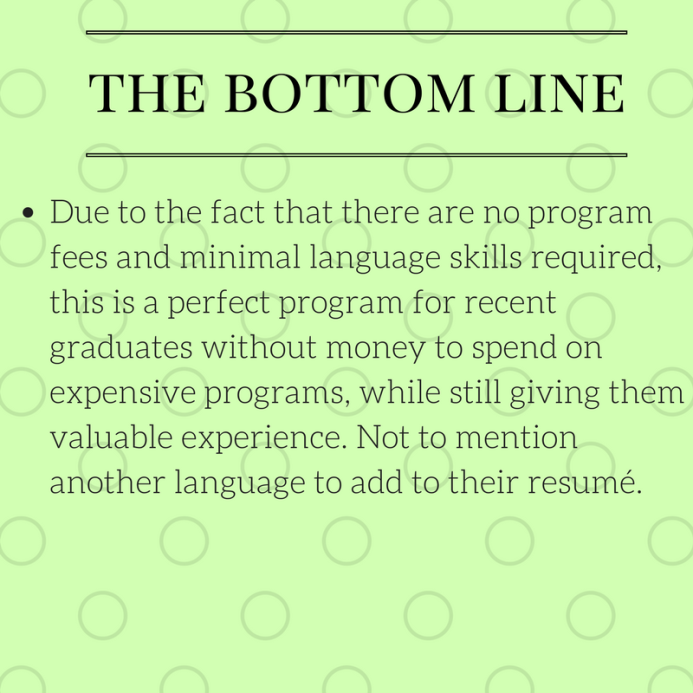
Think this could be for you? Take a look at this to read the answers to some frequently asked questions, answered by the program itself. You can go to their page here to find out what you need to apply and get your Profex application started! Its the easiest application you’ll ever do. Just kidding, its a mess. But not impossible. In all seriousness, their website has improved in the last few years and they set out pretty clearly what the guidelines and checklist are for applying.
DEADLINE FOR 2017-2018: Online applications accepted until April 18th, 2017. Hard copies of official documents must be received by April 23rd, 2017.
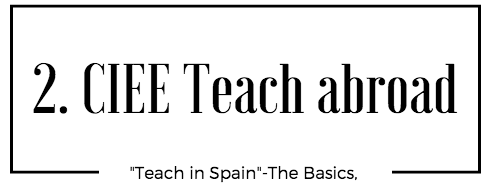
CIEE is a well-known and reputable company that works with study abroad programs as well as teach abroad programs. I studied abroad with them in 2009 and I have them to thank for being one of the stepping stones to where I am now. When I was applying for Auxiliares, a friend of mine applied instead with CIEE, thinking it sounded more organized and official than Auxiliares. (This is true, just taking one look at their website you can tell their budget is years beyond that of the Spanish government). At times Auxiliares didn’t even seem real it was so unorganized. (I wasn’t even sure my school was going to know who I was when I showed up my first day to work.) So, she ended up paying the $1,200 fee of CIEE Teach in Spain-the Basics, which includes, according to their website the following:
- Job placement (this seems obvious by the face that you’re literally PAYING to teach abroad..)
- Pre-departure assistance including visa assistance
- 24 hour emergency support while abroad
- iNext insurance with 24 hr assistance, (I don’t think this is anything more than a private insurance company, which is also covered by Auxiliares for free)
- Assistance finding housing
- Intense, fun orientation for two days before program begins (I snuck into this with my friend. It was just as “fun” and “intense” as the Auxiliar orientation)
- Two nights hotel stay during orientation
- Practical, cultural, professional development activities relevant to your stay in Spain
This is The Basics program which is only for people with intermediate to advanced language skills and teaching experience and it still costs $1,200. The nice thing about CIEE is that they give you quite a few options to tailor-make your experience according to your language and experience level. They even have language immersion options for 2 or 4 weeks including a TEFL certificate, all for a price of course.

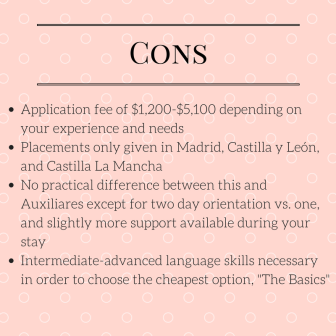

DEADLINE FOR 2017-2018: March 1st, 2017
Think this might be just what you’re looking for? Check out their website for more deets on eligibility and guidelines. CIEE also has tons of other teach abroad options all around the world from Senegal to South Korea.

I applied for this program after doing Auxiliares for two years and thinking maybe, just maybe, I should get some kind of higher education under my belt. My boyfriend had been accepted to do a doctorate program in Madrid so it seemed like the stars had aligned. But, as stars sometimes do, they changed positions and Madrid was no longer looking like the best option. A friend of mine who worked with me in a summer camp one year in Seville had done the program and told me one thing: “it was the most exhausting year of my life”.
The program itself sounds like a fantastic opportunity to get a masters for free while at the same time gaining valuable experience in the classroom. You choose a one year masters in in Teaching Spanish as a Foreign Language, International Education or Bilingual and Multicultural Education, which you complete by doing a combination of online and in person classes in addition to working as a language assistant, (yup, you’re still an auxiliar), for between 18-25 hours a week. There are two options for payment in the program. The total cost is $3,800. But don’t let that number scare you! According to their website, there are two options for payment:
OPTION A: Student requests a placement in a charter or private school (Comunidad de Madrid) as language assistant and applies for Financial Aid and Tuition Remission. There is a limited number of placements.
Student obtains:
- Between €600 and €800 per month (9,5 months)
- Health insurance
- Tuition remission
OPTION B: Student requests a placement in a public school (Comunidad de Madrid) as language assistant. Under this option student gets a monthly stipend and pays tuition.
Student obtains:
- €1,000 per month (9 months)*
- Health insurance*
All school placements are in the Community of Madrid, which means if you are living near the city, things won’t be cheap and that 1,000 euros might be a tight squeeze without an extra source of income. Time, of course is the biggest issue here. In addition to your school duties, which could vary depending on your school, you are also a full time masters student. But for one year, you can do anything 😉


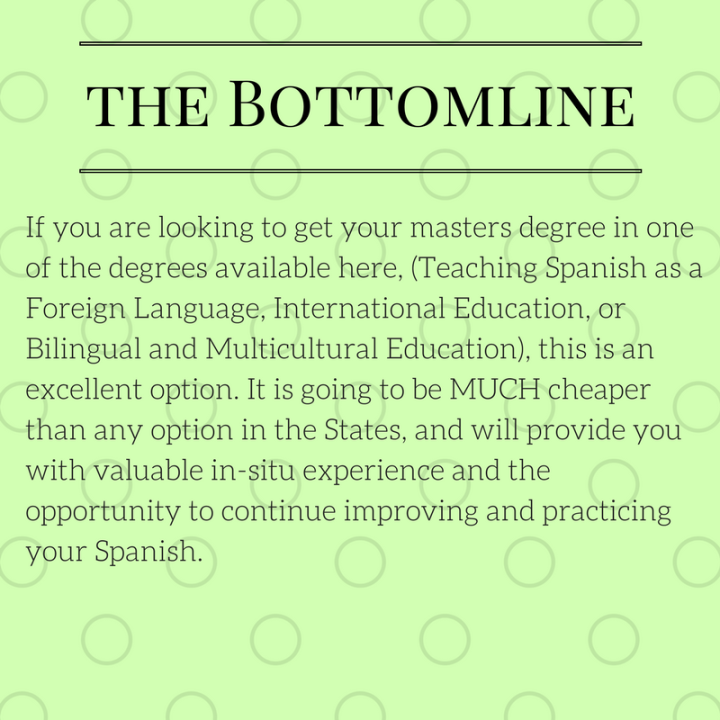
DEADLINE 2017-2018: Unfortunately I came through a little too late for you guys this year to apply, as the deadline was February 24th, 2017. Keep an eye out for next year, as the early bird application process starts around November!

I have never personally worked for Meddeas but I have had plenty of friends who have and have even worked with some of the assistants in my current position as a full time English teacher. Meddeas seems like a happy medium between CIEE and Auxiliares. They have a 6-20 credit online training course to help you get started and have three different programs you can apply for based on your needs. Check out this handy-dandy table here for deets:




Sound good? If you’re still unsure, you can check out some FAQs right here. You can also have a look see at their blog with lots of videos and opinions from past assistants. And if you think you’re ready to apply, I got you covered. Check out the meddeas-application form right meow.
DEADLINE 2017-2018: As far as I can tell, Meddeas is always accepting applications for new positions as they become available. So hop to it!
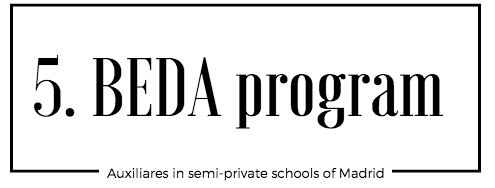
This is the one program of these five that I can’t say I have had personal experience with. But as I’m committed to doing the research so you guys don’t have to, after reading through their entire website, (which you can too, right now, if I’m boring you), what I’ve come to understand that it is basically Auxiliares, but only placed in Madrid and surrounding areas, much like CIEE, but without a high application fee. Another advantage is that there is no language level requirement.There is a $175 fee for the program after you are accepted. This fee includes, according to their website, the following:
- Private health coverage and repatriation coverage
- A course through Comillas University to aid in their work carried out in the classroom & to learn about Spain (obligatory attendance)
- Language assistants training & workshops throughout the year both in and outside Madrid. In Madrid, participants must attend classes and complete an online element. Outside Madrid, participants must attend some sessions in their region and complete the online element. All participants must also attend a 2 day Orientation session at the beginning of September.
- Professional support services from Escuelas Católicas Madrid to assist with residency applications, social security and banking.
- Certificate of completion of the program along with certificates of participation for training sessions (if attendance requirements are met).
You will notice that there is no help with accommodation offered, including the opportunity to live with a family, which you can do with Meddeas. But, the pay scale is a bit higher than Auxiliares, (minimum 878 euros monthly for 18 hours, Auxiliares is 700 euros monthly for 12 hours).
The unique thing about Beda is that each year that you do it, you complete one module of a graduate course. Meaning if you do it for the full four years, (the maximum allowed), you will receive a graduate diploma from Comillas University, much like the Franklin Institute option, but it four years instead of one.


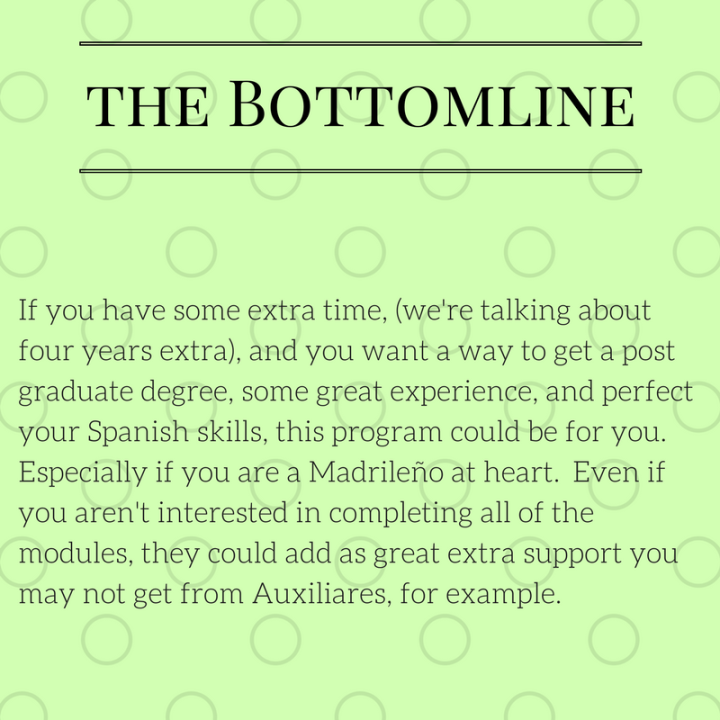
Does this program sound like the perfect combination of what you’re looking for? Check out these documents if you have more questions:
Frequently asked questions: faq-17-18
Applicant information (you’ll need to know this for the interview): info-17-18
DEADLINE 2017-2018: Sorry to say I came in late again on this one, guys, as the deadline for this year was January 31st, 2017. If it is something you are interested in, keep an eye on their website for next year’s applications which they should start accepting starting November.

So, you may be asking yourself, what now? Now, my friend, you need to do some seriously mulling over. As my ever-wise mother once told me, “its all about choices”. Take a look at each program and decide what is most important to you. Location? Price? Salary? Extra degrees or accreditation? None of these programs is going to be perfect, and what they all have in common is your role in the classroom. Your job will not change much regardless of the program you choose. Luckily for you, I don’t think there are any bad choices to be made here.
In my poor post-college days, Auxiliares was the right choice for me. With private classes and academies, I was able to add to my income and travel as well. I learned A LOT and was forced to do a lot of things for myself and “pick myself up by my bootstraps,” if you will. It wasn’t easy but I would never choose a different path for myself. If you want to know real dirt on Auxiliares, check out my interview with myself, right here.
If you are here, you completed the first step. You’ve consulted the options and you’ve said, “yes,” to that little voice in your head telling you to look for work in Spain. You still have time to get in the programs in Auxiliares, Meddeas, and CIEE for the next school year. So…
What are you waiting for?
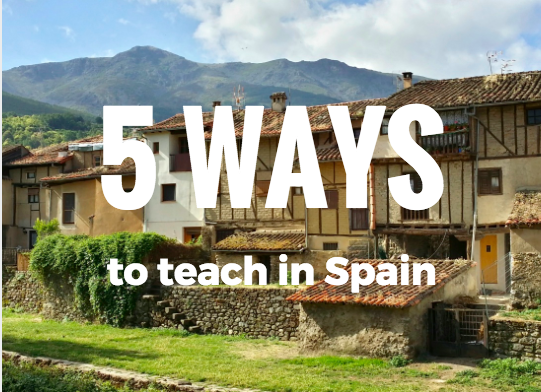

One thought on “5 ways to teach in Spain”